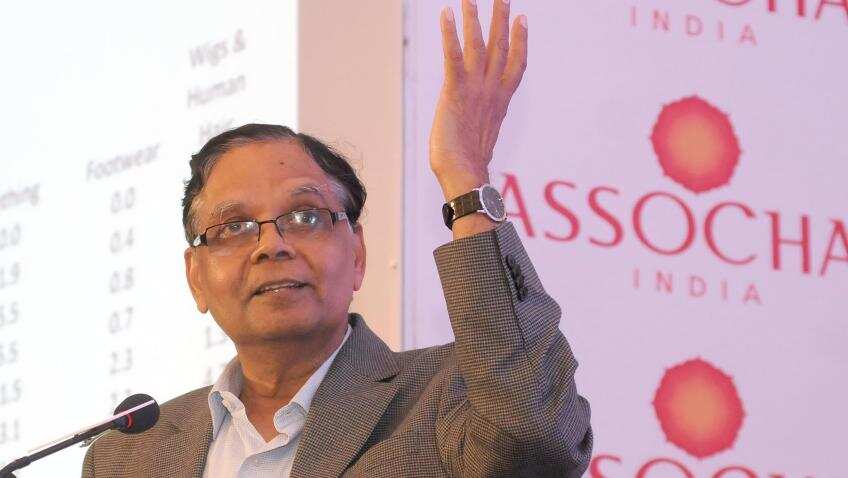Is 'outward orientation' part of government ideology?: Arvind Panagariya

Noting that India has been "slower" than other countries in entering free trade agreements, NITI Aayog Vice-Chairman Arvind Panagariya today said India will need to capture some of the world markets if it has to sustain an 8 to 10% growth rate over the next 20-25 years.
"On the Free Trade areas, India has been certainly slower than other countries," Panagariya said here, at a discussion organised by the Asia Society Policy Institute on the two years of the Indian government, while responding to whether trade-led growth is a priority for the government.
He said that the broader question is whether "outward orientation" is part of the government's strategy of development, adding that his push is in that direction.
"I just don't see that if India trying to sustain a growth rate of 8-10% over a period of 20-25 years, it can be done without actually capturing some of the world markets," he said.
He added that apart from liberalisation, India would also need to focus on "internal reforms" like trade facilitation, speed at which goods can move in and out of the country and the various clearances required.
He noted that India's internal goods market is less than a $1 trillion, while merchandise exports stand at $18 trillion in the world market.
In China, he said, wages have been rising over 10% a year for more than a decade and currently they are 2-3 times the wages in India on an average.
"Wages are likely to rise much faster than they will rise in India. Lot of labour intensive firms are moving out of China and India ought to be the natural destination for them," he added.
When asked if India could look at joining the Trans-Pacific Partnership (TPP), Panagariya said that the TPP is not on India's horizon "at this stage".
"A lot of the things that India would need to do to be a member of the TPP remain to be done, like on intellectual property, government procurement and labour standards," he said.
"These are all very integral parts of the TPP and India is below the standards that are required in the TPP in these areas," he added.
Referring to the H1-B visas, Panagariya said that when you raise fees like this on a commitment in a way that effectively threatens to take away a concession that was actually given, then "politically it does not generate a very good reaction on the other side".
On job creation, he said that unemployment is not a big issue in India but the "big problem" in the country is "underemployment".
He cited the example of the agriculture sector, saying that about 49% of the workforce produces about 15% of the GDP.
"Clearly there is gross underemployment," he said, adding that productivity issues need to be addressed.
Panagariya said that trade agreements, like with Asia-Pacific Economic Cooperation (APEC), will be a "stepping stone" and APEC by itself "is not going to get you very far".
On the goods and services tax (GST) front, he said that the GST reform is very much on the agenda.
While the Congress party wants an 18% cap on the GST to be put into the Constitution, the government is very reluctant to do that.
"That is the issue on which the resolution has to happen. I personally think it will certainly happen. This is a high priority for the government," he said, adding that for the Congress party also under the UPA regime the GST was a high priority item but it did not get done.
"I remain optimistic. GST is a process even after the legislative documents are in place, there will still be a transition to GST. It is a process that takes some time. I'm not worried about GST," he added.
Get Latest Business News, Stock Market Updates and Videos; Check your tax outgo through Income Tax Calculator and save money through our Personal Finance coverage. Check Business Breaking News Live on Zee Business Twitter and Facebook. Subscribe on YouTube.
RECOMMENDED STORIES

Power of Compounding: How long it will take to build Rs 5 crore corpus with Rs 5,000, Rs 10,000 and Rs 15,000 monthly investments?

Small SIP, Big Impact: Rs 1,111 monthly SIP for 40 years, Rs 11,111 for 20 years or Rs 22,222 for 10 years, which do you think works best?

SBI 444-day FD vs PNB 400-day FD: Here's what general and senior citizens will get in maturity on Rs 3.5 lakh and 7 lakh investments in special FDs?

Looking for short term investment ideas? Analysts suggest buying these 2 stocks for potential gain; check targets
12:27 PM IST









 India should resist being too ambitious about growth: Raghuram Rajan
India should resist being too ambitious about growth: Raghuram Rajan Growth recovery in India becoming more broad-based with rise in FDI: Morgan Stanley
Growth recovery in India becoming more broad-based with rise in FDI: Morgan Stanley Morgan Stanley says ‘buy’ India; four reasons why
Morgan Stanley says ‘buy’ India; four reasons why